Chapter: Human Nervous System and Sensory Organs : Telencephalon
Frontal Sections of Brain Through the Telencephalon
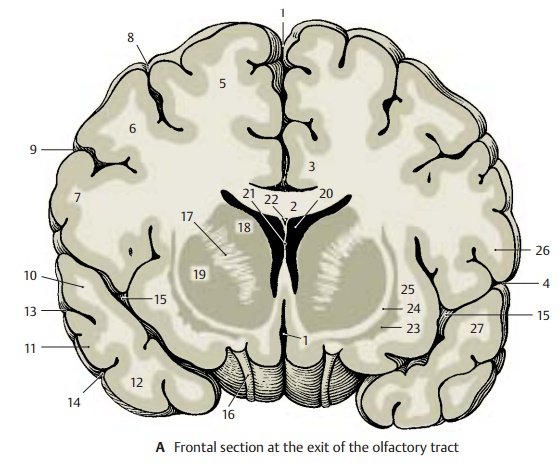
Sections Through the Telencephalon
Frontal Sections
The posterior cut surface is shown for each brain section.
1. Section at the Level of the Exit of the Olfactory Tract
2. Section at the Level of the Anterior Commissure
3. Section at the Level of the AmygdaloidBody
4. Section at the Level of the Hippocampus
5. Section at the Level of Midbrain and Pons
6. Section at the Level of the Splenium of the Corpus Callosum
Section at the Level of the Exit of the Olfactory Tract (A)
The cut surface shows the two hemispheres separated by the cerebral longitudinal fissure (AB1); the gray matter (cortex and nuclei) is easily distinguished from the white matter (myelinated fiber masses). The corpus callo-sum (AB2) connects the two hemispheres.The section shows the cingulate gyrus (AB3) above the corpus callosum.
The lateral field of the section shows the deep lateral sulcus (AB4). Dorsally to it lies the frontal lobe with the superior frontalgyrus(AB5), the middle frontal gyrus (AB6),and the inferior frontal gyrus (AB7). They are separated by the superior frontal sulcus (AB8) and the inferior frontal sulcus (AB9). Ventrally to the lateral sulcus lies the tem-poral lobe with the superior temporal gyrus (AB10), the middle temporal gyrus (AB11), and the inferior temporal gyrus (AB12). The temporal gyri are separated by the superiortemporal sulcus (AB13) and inferior temporal sulcus (AB14). The lateral sulcus expandsdeep into the lateral fossa (fossa of Sylvius) (AB15), on the inner surface of which is the insula. The insular cortex extends basally al-most to the exit of the olfactory tract (A16). It represents a transitional area between paleocortex and neocortex.
In the depth of the hemisphere lies the neo-striatum which is divided by the internal capsule (AB17) into the caudate nucleus AB18) and the putamen (AB19). The section shows the anterior horn (AB20) of the lateral ventricle. The lateral wall of the ventricle is formed by the caudate nucleus, while its medial wall is formed by the septum pel-lucidum (AB21) containing the cavity of the septum pellucidum (AB22). At the lateralaspect of the putamen lies a narrow, cup-shaped layer of gray matter, the claustrum (AB23). It is separated from the putamen by the external capsule (AB24) and from the in-sular cortex by the extreme capsule (AB25
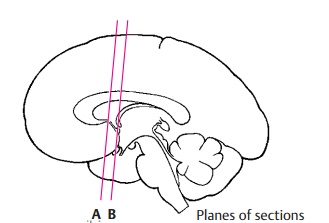
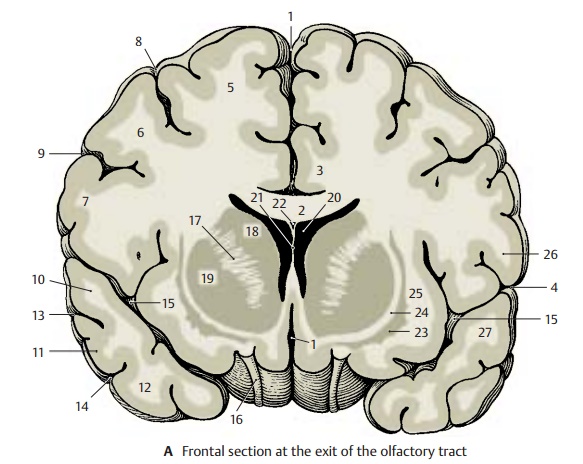
Section at the Level of the Anterior Commissure (B)
At this level, the section shows the central regions of the frontal lobe and the temporal lobe. The lateral fossa is closed, and the in-sula is covered by the frontal operculum (AB26) and the temporal operculum (AB27). The ventral regions of both hemispheres are connected by the anterior commissure (B28) where fibers of the paleocortex and the temporal neocortex cross. Above the com-missure appears the globus pallidus (B29) (part of the diencephalon), and close to the midline lies the septum pellucidum (AB21), or more specifically, its wide ventral seg-ment containing the septal nuclei (also known as peduncle of the septum pel-lucidum). The mediobasal aspect of the hemisphere is covered by the paleocortex, the olfactory cortex (B30).
Claustrum. In the past, the claustrum (AB23) was either grouped together with the striatum to form the so-called basal gan-glia or was assigned to the insular cortex as an additional cortical layer. Developmental studies and comparative anatomical inves-tigations, however, suggest that it consists of cell clusters of the paleocortex which have become displaced during development. The claustrum merges with its wide base into paleocortical regions (namely, the prepiri-form cortex and the lateral nucleus of the amygdaloid body). Unmyelinated fibers from the cortices of parietal, temporal, and occipital lobes are thought to terminate in the claustrum in a topical arrangement. The function of the claustrum is largely un-known.
B31 Optic chiasm.

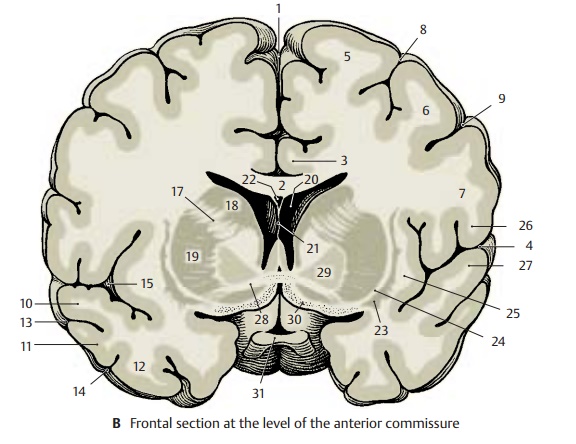
Section at the Level of the AmygdaloidBody (A)
At this level the central sulcus (AB1), which runs obliquely from dorsocaudal to ven- trorostal, has been cut in the more rostral part; the frontal lobe, which is dorsal to it, therefore occupies a far larger part of the section than the parietal lobe, which is ven- tral to it. The convolution above the central sulcus is the precentral gyrus (AB2); the con- volution below it is the postcentral gyrus (AB3). Deep in the temporal lobe appears the amygdaloid body (amygdala) (A4). It reaches the surface at the medial aspect of the temporal lobe and might therefore be regarded partly as cortex, partly as nucleus, or rather as a transition between the two structures. Since not only the surrounding periamygdalar cortex but also its cortico- medial half belong to the primary olfactory centers, the amygdaloid body can be as- signed to the paleocortex, despite its nuclear features. The claustrum (AB5) ends above this region with a wide base. Between the hemispheres lies the dien- cephalon with thalamus (AB6), globus pal- lidus (AB7), and hypothalamus (A8). Later- ally to the diencephalic nuclei border the neostriatum with putamen (AB9) and cau- date nucleus (AB10). Below the corpus callo- sum (AB11) lies a strong fiber bundle, the fornix (AB12). Also seen are the longitudinal cerebral fissure (AB13), the lateral cerebral sulcus (AB14), the lateral fossa (AB15), the optic tract (A16), and the infundibulum (A17).
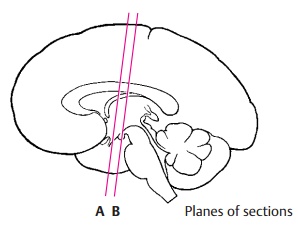
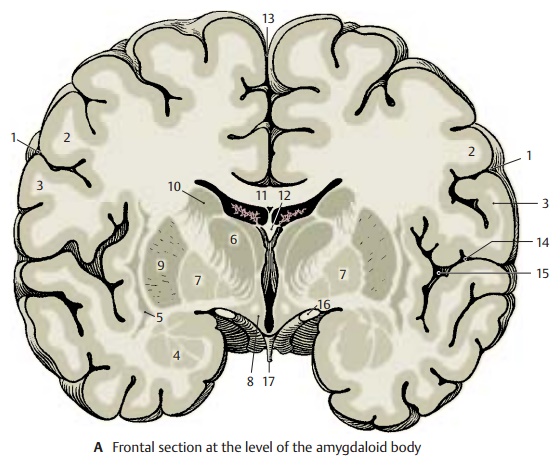

Section at the Level of the Hippocampus (B)
Once the more caudally cut sections no longer show the amygdaloid body, the hip- pocampus (B18) appears in the medial area of the temporal lobe. This most important portion of the archicortex is a cortical for- mation that has curled up and projects against the inferior horn of the lateral ven- tricle (B23). The section also shows theinner surface of the temporal operculum ex- hibits prominent convolutions; these the obliquely cut transverse temporal(B19), or Heschl’s convolutions, repre- senting the auditory cortex. In the ventral region of the diencephalon lie the sub- thalamic body (B20), the mamillary body (B21), and the substantia nigra (B22), which is a part of the midbrain.

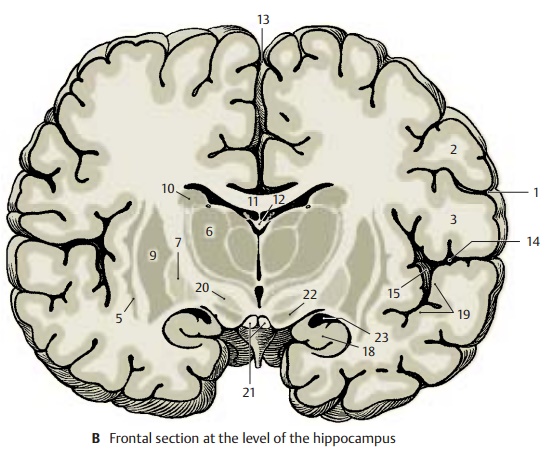
Basal Gaglia. The gray nuclear complexes deep in the hemisphere are collectively known as basal ganglia. Some authors use the term only for the striatum and the pal- lidum, while others include the amygdaloid body and the claustrum, some even the thalamus. As this term is vague and ill-de- fined, it is not used in the present descrip- tion. Earlier anatomists viewed th lidum and the putamen as parts of the len- tiform nucleus (a concept still surviving as lenticular ansa and lenticular fasciculus), a term that is no longer used.
Section at the Level of Midbrain and Pons (A)
The caudal portion of the lateral fossa (A1) is open to the lateral aspect of the hemi-sphere. Dorsally to the lateral sulcus (A2) lies the parietal lobe, ventrally the temporal lobe. The dorsal convolutions of the latter, which lie deep in the lateral sulcus and rep-resent thetransverse temporal gyri (A3), are cut obliquely. At the bottom of the lateral fossa lies the insular cortex, which rests on the caudal extensions of claustrum (A4) and putamen (A5). The cau-date nucleus (A6) appears at the lateral wallof the lateral ventricle (A7). At the medial aspect of the temporal lobe, concealed by the parahippocampal gyrus (A8), the cortex curls up to form the hippocampus (Ammon’shorn) (A9). Corpus callosum (A10) and for-nix (A11) are seen above the choroid plexus.
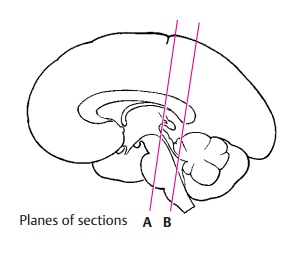
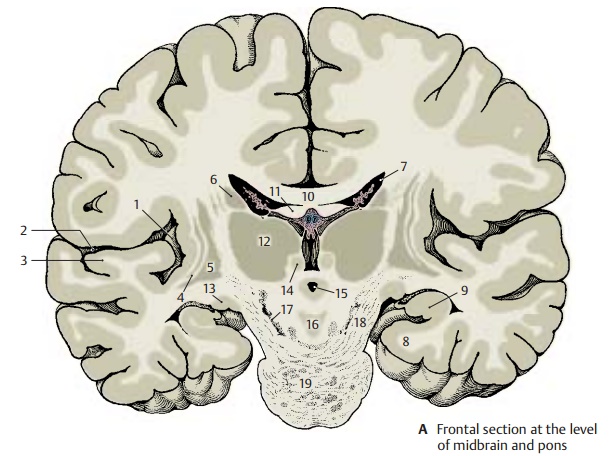
The field between the hemispheres repre-sents the transition between diencephalon and midbrain. The section shows the caudal nuclear regions of the thalamus (A12). Sepa-rated from the main complex lies the lateralgeniculate body (A13), and medially to theventricular wall lies the habenular nucleus (A14). The plane of section has been oriented according to Forel’s axis, thus showing telencephalon and dien-cephalon in frontal section, while the struc-tures of midbrain and pons (Meynert’s axis; p. 4, B) have been cut obliquely. Ventral to the aqueduct (A15) lies the decussation ofthe superior cerebellar peduncle (A16). A nar-row strip of dark cells, the substantia nigra (A17), extends ventrally on both sides. The cerebral peduncles (A18) are seen laterally toit; the course of their fiber masses can be traced from the internal capsule to the pons (A19).
Section at the Level of the Splenium of the Corpus Callosum (B)
In this section, the dorsal part of the hemi-sphere belongs to the parietal lobe and the ventral part to the temporal lobe; at this plane of section, the latter is merging into the occipital lobe. The boundary betweenparietal lobe and temporal lobe lies in the region of theangulate gyrus (B20). The lateral sulcus and the lateral fossa are no longer present in the section. The cut sur-face of the corpus callosum is particularly wide at the level of the splenium (B21). Dorsally and ven-trally to it lies the cingulate gyrus (B22), which encircles the splenium in an arch. The parahippocampal gyrus (B23) adjoins ven-trally. Neither the hippocampus nor the cal-carine sulcus are present in the section; hence, the section lies behind the hippo-campus but in front of the calcarine sulcus. The two lateral ventricles are remarkably wide, each representing the most anterior part of the posterior horn at the transition into inferior horn and central part (see p. 281, BC7 – 9).
The lower aspects of the hemispheres border on the cerebellum. The medulla ob-longata appears in the middle, the oblique section shows the fourth ventricle (B24), the olives (B25), and the pyramids (B26).

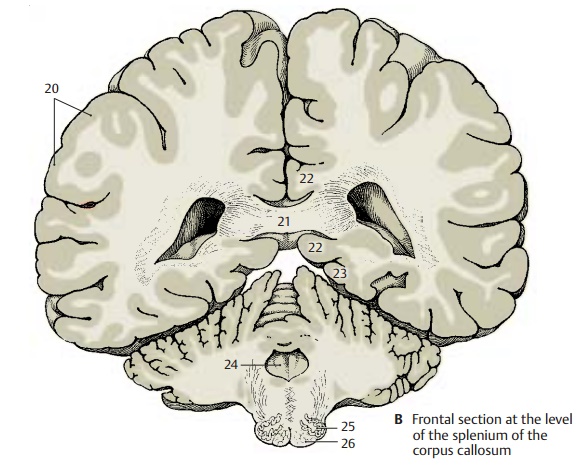
Related Topics